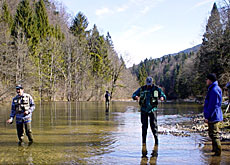Fly-fishing catches on in Switzerland

With more than 262 billion cubic metres of water covering a relatively small space, Switzerland lends itself to water sports such as fly-fishing.
The oldest form of hobby fishing, fly-fishing is gaining popularity in land-locked Switzerland.
It may not be the most efficient way of catching fish, but is an effective means of catching trout and grayling, which predominate in Switzerland’s lakes.
Sergio Rizzoli, an enthusiastic fly-fisherman, grew up in Ticino in the Centovalli valley and started fishing at a very early age.
“I don’t remember exactly the day when I first started fishing. I grew up in a place where two rivers meet, and spent all day looking for fish underneath stones,” Rizzoli told swissinfo.
“When you grow up in Centovalli you only have two choices – you either become a fisherman or a hunter.”
Rizzoli, who now lives in Bern and works as a traffic engineer, is using his fishing skills in a semi-professional way. He manages the Swiss section of the Italian school for fly-fishing.
Art of deception
Fly-fishing is essentially the catching of fish by complete deception. It is often considered an art or science as fly-fishermen use bits of fur and feathers attached to a hook, called the “fly”, to mimic the natural prey of fish.
“Some evil tongues claim that fly-fishing is the best fishing technique for those who do not actually want to catch anything,” Rizzoli said with a smile.
The fish are normally caught when in action. “You have to throw the bait at the right moment – a technique that you have to learn just as you have to learn to play golf,” Rizzoli explains.
However, there is more to fly-fishing than just knowing how to cast the rod. Fly-fishermen also have to learn how to make their artificial flies and in what season to use them.
Active sport
Fly-fishing is a good way of keeping fit as fishermen often end up walking through a river for up to 15 kilometres per day.
“When I go fishing I bond with nature, and for this reason I like going to rivers that are close to my home,” Rizolli told swissinfo.
Since moving to Bern Rizolli has fished in the rivers Aare, Simme and in the Emme.
He regrets that many of the species of trout that he fished for as a boy are now dying out.
“In the past few years people have tried to re-introduce some species using the weirdest methods,” Rizzoli said, adding that these had not been fully successful.
Although the cantonal fishing authorities allow daily catches of different species of trout, Rizzoli believes fly-fishers should exercise restraint in the interests of preserving fish stocks.
“The school I belong to believes in self-imposed limits,” Rizzoli said.
swissinfo, Raffaella Rossello (translation: Billi Bierling)
Fly-fishing is catching a fish with an almost weightless artificial lure or “fly”.
The “fly” is made of fur, feathers and synthetic materials which are tied to a hook in an attempt to imitate the size, shape and colour of the food form that the fish feeds upon.
Fly fishing is typically practised using a fly rod, fly reel, fly line, tapered leader and of course a fly.
Fly-fishing is the oldest form of hobby fishing known to man.

In compliance with the JTI standards
More: SWI swissinfo.ch certified by the Journalism Trust Initiative
You can find an overview of ongoing debates with our journalists here . Please join us!
If you want to start a conversation about a topic raised in this article or want to report factual errors, email us at english@swissinfo.ch.